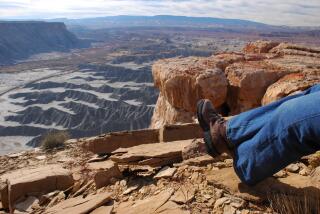Making up for lost wilderness
- Share via
On Monday, President Obama signed the Omnibus Public Lands Management Act, placing more than 2 million acres of public land in nine states under Wilderness Act protection. The new legislation preserves remote glacial valleys in Wyoming, fragile deserts in California and dense forests in northern Michigan, making these and other tracts of pristine land permanently off-limits to road building, oil and gas drilling and commercial timber harvesting.
But for all the joy the law brings to those who treasure America’s wild places, it was nevertheless a bittersweet victory. After eight years of the George W. Bush administration’s assault on public lands, there’s still so much to be done -- and undone.
During the Bush era, millions of acres of public land were leased for oil and gas drilling and logging. The Endangered Species Act was ignored and weakened. Snowmobiles and off-road vehicles were allowed to invade national forests and parks. Mountaintops in the Appalachians were dynamited to mine coal.
The damage was so deep that it’s hard to know where to begin. But let’s start with oil and gas exploration. On President Bush’s watch, vast tracts of undeveloped public land were opened to drilling, and federal employees were directed to expedite the process. Utah field officers for the Bureau of Land Management, for example, were told by supervisors in one memorandum to instruct staff that “when an oil and gas lease parcel or when an application to drill comes in the door
The Bush administration also ignored rules that had been put in place to protect undeveloped public lands. The Clinton administration’s “Roadless Area Conservation Rule” was aimed at stopping road building in 58.5 million acres of forest lands. But when Bush came into office, officials of his administration let it be known that the Justice Department would not defend the rule. Soon, battles raged in courts across the West, producing conflicting decisions. Because of the legal disputes, only seven miles of proposed forest roads have been built, but the rule’s ultimate fate is still undecided.
And then there is the Endangered Species Act. During the Bush years, the U.S. Fish and Wildlife Service was loath to extend protections to new plants and animals. By 2007, it had voluntarily listed only four new species. Petitions and lawsuits by environmental groups had forced the addition of 54 more species. But meanwhile, 279 candidates for listing were stuck in an interminable review process.
And even when species did make it on the list, the department refused to designate “critical habitat” necessary for the species’ survival. In late 2008, the Interior Department inspector general, Earl E. Devaney, concluded that political interference by department brass repeatedly overturned scientific reviews and that there was “an unwritten policy to exclude as many areas as practicable from critical habitat designation.”
But the report did little to curb the Bush administration. Shortly before leaving office, it issued new rules declaring that federal agencies whose plans might affect endangered species no longer needed to consult with the Fish and Wildlife Service or the National Marine Fisheries Service before proceeding.
Another Bush rule declared that when any Arctic species, such as polar bears, was under review for listing, scientists and officials could not consider the effects of greenhouse gases produced outside the Arctic.
Gale Norton, Bush’s first secretary of the Interior, loved snowmobiles and off-road vehicles, and pushed the gates to the nation’s public lands wide open for them. Today, more than 60,000 snowmobiles roam Yellowstone and Grand Teton National Parks each winter, creating a blue haze of exhaust along popular trails. Park workers don government-issued respirators and hearing protection because of hydrocarbon emissions that are 10 times higher than on Los Angeles’ freeways and noise levels approaching those of large airports.
It was the Bush administration’s utter disregard of the Clean Water Act that made it possible for the coal industry to destroy a large swath of the Appalachians. At first, the administration simply ignored the act and issued permits that allowed coal companies to dump mining waste into streams. Then, in 2002, after losing legal challenges, it issued rules that made “valley fill” specifically exempt from the clean-water law. Two years later, it began to undo another rule, one that said debris couldn’t be dumped too near streams. In December 2008, this requirement was officially removed. About 2,000 miles of Appalachian streams now lie buried under mining debris.
--
The Obama administration and Congress should be applauded for protecting 2 million acres of public land, but that does not begin to make up for all that was lost during the Bush years. And swift action is necessary to stop further erosion of environmental protections. Interior Secretary Ken Salazar has only until May 9 to reverse the Bush changes to Endangered Species Act rules. Obama should order his Justice Department to settle lawsuits filed by environmental groups, vacating many Bush policies. And Congress needs to pass a strong legislative package, bills such as the proposed Roadless Area Conservation Act, which would protect wilderness areas in our national forests.
Not all of the damage to our land and its creatures can be reversed. But new laws and federal regulations could at least create a solid legal foundation on which large-scale restoration can begin.
More to Read
Sign up for The Wild
We’ll help you find the best places to hike, bike and run, as well as the perfect silent spots for meditation and yoga.
You may occasionally receive promotional content from the Los Angeles Times.






